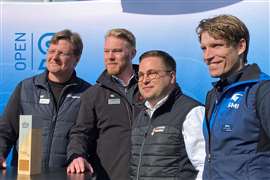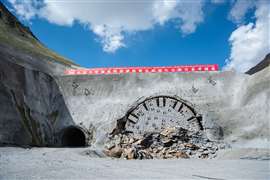Satellite Systems
11 April 2008
GPS systems used in construction have developed at a rapid pace and are replacing traditional surveying on the jobsite as well as allowing automatic machine control. The technology is allowing worksites to become increasingly integrated, which manufacturers claim increases productivity and efficiency.
Achiel Sturm, construction support group manager and product marketing manager for Topcon Europe, said the most important development in GPS during the last couple of years has been the integration of equipment on site. He added another big development is the software used with GPS technology, which now features more built-in functionality.
Mr Sturm said the biggest benefit of using GPS in the construction industry is the shift away from surveyors having to stake out a construction site, which increases site safety.
“The whole stake-out process has moved towards the office where 3D models are compiled and are uploaded onto a machine,” he said. He added this means surveyors are more often used for checking purposes, which allows companies to make huge savings on surveying costs.
“The biggest development is the acceptance of these GPS systems in the market – it's not quite there yet, but it is getting there. It's pretty rare to see a machine on a jobsite without any kind of GPS system today,” Mr Sturm said.
According to Mr Strum the acceptance of the technology varies in different countries but in the UK, Germany, France, Spain, Scandinavia and The Netherlands most large earthmoving machines are equipped with GPS systems. Germany and Scandinavia in particular are at the forefront of these developments.
“What we see in Eastern Europe is that an investment in a 3D system for GPS is quite expensive but of course with new EU money going into developing new roads we see some movement there – especially in countries like Poland and the Czech Republic – they are really catching up now,” he said.
Mr Sturm said Topcon is ready and waiting for the start of the Galileo satellite, adding that the addition of another satellite system would increase available working hours and improve accuracy and reliability of the job.
Currently there are two fully operational satellite networks for use in GPS-based systems including the US military GPS network (NAVSTAR) and the Russian owned network, known as GLONASS, which is being updated. The key development in this area will be the launch of the European system – Galileo.
For Leica, future developments also centre on the launch of the Galileo satellite system, according to Valentin Fuchs, Leica's product manager for positioning.
He said, “It will bring some really significant benefits – not so much on the accuracy side but more on the coverage – so you can work with GPS in areas where you couldn't work before.”
Automated Worksite
According to Mr Sturm the focus now is to automate the entire construction site and Topcon has already addressed this with its SiteLink product, which allows information to be shared among the machines working on the same jobsite.
Mr Sturm said the hardware for the SiteLink system is ready but the software is still being finalised and the first working software solution should be ready in Europe next summer.
He said, “I think the industry is aware of the systems but I don't think that people know the impact of what systems like these have on a jobsite and that's a message we are trying to push.”
He added all the big manufacturers are already up to speed with the technology and are feeding the market with this information.
Hitachi has launched its remote fleet management and preventative maintenance tool – the e-Service Owner's Site. This satellite communication unit is available on all of the new Hitachi Zaxis-3 excavators and ZW wheel loaders as standard. According to Hitachi the product provides remote access to all relevant machine information, such as hours of use and machine operation data, including pressures and temperatures, fuel levels, maintenance history, recommended service and inspection intervals.
A spokesman for Hitachi said, “Every Zaxis-3 excavator and ZW wheel loader regularly sends operational machine data to a satellite. If an alarm appears on the colour LCD monitor in the machine's cabin, this data is also sent to the satellite at the earliest possible opportunity. The satellite then redirects the alarm via a ground station to a Hitachi server in Japan.”
Data is collected and directed to customers around the world and this information can then be accessed online by the relevant dealer and customer at a dedicated section on the Hitachi Global e-Service website, the spokesman added. This helps to increase productivity and reduce downtime, as diagnostic engineers do not need to be sent to inspect the machines.
“Another useful function of the e-Service Owner's Site is the geographical information system (GIS) which is based on GPS input data. The GIS allows customers to search for the exact location of single machines and also perform multiple machine searches,” the spokesman said.
Similarly, Volvo's new telematics CareTrack system allows machinery to be monitored day and night from a remote location and passes on analytical information about machine behaviour, productivity, fuel consumption and its location.
Arvid Rinaldo, marketing and communications manager for Volvo CE's haulers and loaders, said the future of GPS in the construction industry will focus on the connected worksite. He added machine information, which is accessed by signing onto the system via a computer, can be used by contractors to optimise performance, step up productivity and increase uptime.
“The reason these systems are important today is because running this kind of business is becoming more complicated and the margin is becoming more important. Companies are getting bigger and they own more machines and this means that they have to run more efficiently and keep a close track of their costs. The technology has given us the opportunity to do that.” Mr Rinaldo said.
Flexible Sensors
Leica's new RedLine sensor and software system, is the company's most recent and significant GPS development, according to Mr Fuchs. The system allows the same sensors to be used for various construction tasks, from base station set-up, machine control and surveying needs, controlled by a simple user interface.
Mr Fuchs said, “It is the first time that Leica Geosystems can cover the whole work flow with one complete product portfolio which is designed for construction workers rather than skilled surveyors.”
He added the sensors offer flexibility and versatility on a jobsite.
“We wanted to have sensors and solutions that could provide multiple applications. So for instance when we are talking about a GPS site you can have a power box and power antenna and both applications can be used for on-machine application like machine control as well as off-machine applications such as survey tasks with the foreman, as well as using it as a base station,” Mr Fuchs said.
He added the major improvement with the sensor line is not so much the accuracy but its usability.
Future Trends
The future of GPS in the construction industry is focused on further integration of the jobsite. Manufacturers of these systems as well as the construction equipment manufacturers agree that improving the flow of information on a site will enhance productivity and efficiency as well as reducing costs.
Assistant manager for Volvo's CareTrack system, Joakim Svensson, said in future CareTrack would be standard on all Volvo construction equipment. “It's hard to say when this will happen, it depends on the customer demand and the in-house value of having it,” he added.
He said encouraging the industry in some countries to use the new technology has been the hardest part of the project but added customer demand has increasingly grown for the system since it was introduced.
Mr Rinaldo said the challenge now is to train people to manage the system and to ensure people understand the benefits, such as the integration of service planning and business management.
Meanwhile, Hamid Lavassani, manager for Cat's civil and road construction division in Europe told CE, “I don't think the machines will be secondary to the GPS systems... The future of GPS systems is making the operator's job so easy that at the end of the day the margin of error is as close to zero as possible. That is what we are striving for.”






